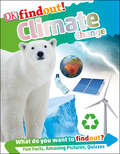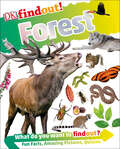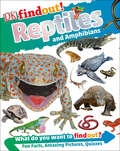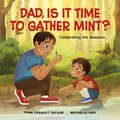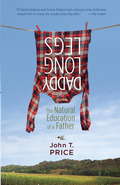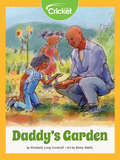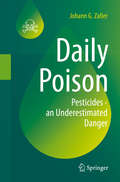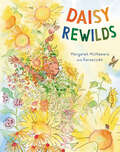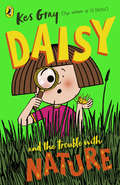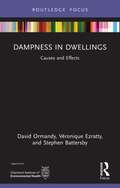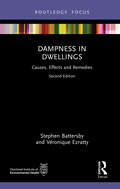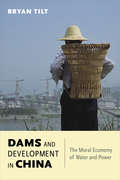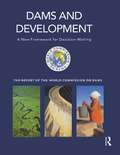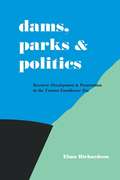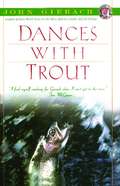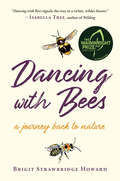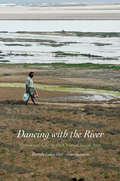- Table View
- List View
DKfindout! Climate Change (DK findout!)
by DKThis timely entry into the award-winning DKfindout! Series, explores the past, present, and future of our climate.In 2019 kids around the world went on strike for the future of our planet, and for their own futures. This amazing book on climate change for kids covers what we can do every day as potential activists to help prevent further damaging changes to the climate.The subject matter of this book has become a very hot topic! Find out why climate change is such a big deal. It contains a wealth of facts about the world, figures, predictions and graphical data to help you understand exactly what it all means. It is a great addition to any bookshelf, and a valuable and contemporary resource for all ages.Climate change is now one of the biggest issues we face as a society, and the British and Irish governments have become the first in the world to declare a climate emergency. This book lays out the science behind this natural process that has been exponentially sped up by humans. It explains the different ways in which we have caused the Earth to heat up, from traffic pollution to animal farming, and the vast, widespread effects we are causing.It covers key developments such as the industrial revolution, the advent of air travel, and climate activism, such as the People's Climate March to Greta Thunberg and the Extinction Rebellion. Come to understand the facts about climate change in these pages and discover what we can do to improve the human impact on our environment.Find Out How To Save The World!A small book filled with fun facts and big ideas! Over 64 pages are packed with information covering all the aspects of climate change including a timeline dating from the 1760s all the way through to 2050, to living with climate change and what we can do about it.Dkfindout! Climate Change encourages children to think more about the world around them and is a great aid for any school project on climate change.Inside you will: -Learn about deforestation, the greenhouse effect and transport-Discover the polar crisis, changing sea levels and sinking islands-Explore activism, collective change, and small ways to make a differenceDkfindout! Climate Change is one title in the Dkfindout! series of educational books for kids, and Silver award winner in the MadeForMums Awards 2017 children's books series category. Kids around the world are obsessed with this gorgeous collection, so much so that a range of massive DKfindout! posters for bedroom walls are sold separately. Add to your collection and nurture your little one's interest in the world. Other titles include DKfindout! Solar System, Birds, Castles, Science, Pirates, Coding, Ancient Egypt, Engineering, Reptiles and a whole lot more!
DKfindout! Forest (DK findout!)
by DKExplore the flora and fauna from all around the world with this exciting book full of amazing images, fun quizzes, and incredible information.Discover all types of forests—from rain forests to boreal forests—and where they are found, learn about the different animals that make their homes there, explore how forests change through the seasons, and find out about forest conservation.Filled with colorful images and quirky facts, DK findout! Forest is engaging and educational. Pull out the special cover flaps to see extra information and take a quiz on everything covered in the book.Learn more about forests—or anything else—at www.dkfindout.com, a free educational website for kids to have fun with information and expand their knowledge.Series Overview: From the creators of DK findout!, the free online resource for kids, comes an exciting book series full of amazing images, incredible quizzes, and cutting-edge information kids need to know. The DK findout! series helps kids become experts on their favorite subjects—from dinosaurs to space. Learning doesn't get more fun.
DKfindout! Garbage (DK findout!)
by DKFind out how to live more sustainably, manage waste better, and create an eco-home!Garbage tells us a lot about how humans have lived in the past, how we&’re living now, and the impact our waste disposal has on the environment. To create a more sustainable future, it&’s important that little eco-warriors know about the different types of waste and how to create less garbage! DKfindout! Garbage is a fun, trivia, and activity-filled book that teaches young children between 5 and 9 years old about the problems the planet is experiencing with waste. Published to engaged young activists keen to make a difference, this waste management book: • Covers topics such as &“Electronic waste&”, &“Food we waste the most&”, and &“Recycling ideas for kids&” with a clear visual approach • Includes a glossary to help explain new or tricky terms • Contains flaps at the beginning and end that provide extra core references and a quiz to draw children into the content of the book • Features dynamic, highly visual presented topics including a spread about art made from garbage • Checked by specialist consultants and an educational expert to make sure the information is trustworthy and age-appropriate Teach children how important it is to throw out your trash and recycleThought-provoking and timely, DKfindout! Garbage educates and challenges young readers to ask questions about how garbage is created, disposed of, the biggest contributors to excess waste such as fast fashion, plastic, and electronics - and how they can counter the effects of these culprits. An important yet colorful sustainability book for kids, this title teaches children how to produce less waste and how to manage waste better! They&’ll learn about recycling, upcycling (even creating art from garbage!), how to stop wasting food, and why plastic is a problem. More titles to Findout!This DKfindout! series introduces children to a range of exciting topics in a fun, engaging way. Checked by specialist consultants and an educational expert, this is not only a source of information you can trust but one that is age-appropriate and supports your child&’s schoolwork. Other titles include DKfindout! Science, DKfindout Animals, and DKfindout! Forest.DKfindout! series won Silver in the MadeForMums Awards 2017.
DKfindout! Reptiles and Amphibians (DK findout!)
by DKSupporting STEM-based learning, this fact-filled book for lizard lovers ages 6–9 is the ultimate guide to reptiles and amphibians from across the globe, entertaining and educating young readers through a combination of close-up images, quirky trivia facts, quiz questions, and fascinating tidbits on everything from turtles to tree frogs.What is the difference between a reptile and an amphibian? How do chameleons change their colors? How many types of frogs and toads are in the world today? Find out the answers to these questions and more in DKfindout! Reptiles and Amphibians, which features stunning wildlife photography of these animals in their native environments, throughout every stage of their life cycles. Beginning with a broad overview of taxonomy and biology, this book teaches young herpetologists what separates reptiles and amphibians from other branches of the animal kingdom, while in-depth sections on particular species show how animals have adapted to their surroundings with different mating behaviors and defense mechanisms. From chameleons to Komodo dragons, DKfindout! Reptiles and Amphibians captures the breadth of this wriggling, slithering world in a unique and fun way.Vetted by educational consultants, the DKfindout! series drives kids ages 6–9 to become experts on more than 30 of their favorite STEM- and history-related subjects, whether Vikings, volcanoes, or robots. This series covers the subjects that kids really want to learn about—ones that have a direct impact on the world around them, like climate change, space exploration, and rapidly evolving technology—making learning fun through amazing images, stimulating quizzes, and cutting-edge information. The DKfindout! series is one that kids will want to turn to again and again.
Dad, Is It Time to Gather Mint?: Celebrating the Seasons (Joshua Learns From the Land)
by Tyna Legault TaylorLearn about the rhythms of the seasons with Joshua in this captivating read-aloud story for ages 5 to 8. Joshua loves being on the land. When the weather is warm, Joshua and his dad gather mint from the shores of Animbiigoo Zaagi’igan Anishinaabek (Lake Nipigon First Nation) in northeastern Ontario. But when will that be? It’s not when the leaves are changing colour. It’s not when the snow falls from the sky. It’s not when the flowers are budding. When is it time to gather mint from the land? In the back of the book, find a glossary and pronunciation guide for the Swampy Cree and Anishinaabemowin words featured throughout the story.
Daddy Long Legs: The Natural Education of a Father
by John PriceJohn Price appears to have thrown in the towel. He has spent the last year struggling to support his family, neglecting to spend time with his wife and children, and becoming increasingly cynical about the degraded state of the natural world around him. After a heart-attack scare, however, his wife demands that he start appreciating all the "good things" in his life: their mouse-infested old house, their hopelessly overgrown yard, and most of all, the joys and humiliations of parenthood. In his quest to become a better father, Price faces many unexpected challenges--like understanding his grandmother's decision to die, and supporting his nature-loving sons' decision to make their home a "no-kill zone" for all living creatures. Still he finds the second chance he was looking for--to save himself and, perhaps, his small corner of an imperfect yet still beautiful world.
Daddy's Garden
by Kimberly Long CockroftAnimals are part of our world and contribute to our environment in different ways; even reptiles like Sammy the snake! Sammy lives in the garden near Merry and her family. Sammy takes care of the pests that eat their garden tomatoes. Merry’s parents show Merry and her sisters how to be safe and gentle with Sammy and all creatures!
Daily Poison: Pesticides - an Underestimated Danger
by Johann G. ZallerThis book is a sound science report about the consequences of pesticides to nature, health and environment.The book shares essential insights into the use of pesticides in agriculture, discusses the politics, rhetoric and profits involved, addresses the potential health and ecological risks of pesticides in our daily lives, and debates possible solutions. Does sustainable agriculture exist, and is agriculture without pesticides possible at all?Moreover, the author gives insight into his scientific work, the set-up of the experiments, and also writes about his very own experiences with the media and press after publication of his studies.For many years, Johann G. Zaller, an ecologist at the University of Natural Resources and Life Sciences in Vienna, and his team, have been researching applied chemicals and their effects on the environment. Their findings, together with relevant literature and media reports, are presented in this book, which offers a unique resource for anyone who wants to know the nature and background of pesticides and how we come into contact with them in our daily lives. Ever ate an apple? Read this book!
Daisy Rewilds
by Margaret McNamaraA young, curious, science-loving environmentalist named Daisy proves to her community the importance of conservation in this whimsical and hopeful story.Daisy was born with a green thumb. As an infant, she composted her own baby food. As a toddler, she slept on a bed of leaves. Now she&’s embarking on her most important experiment: she&’ll plant herself on her manicured front lawn, stay put, and let nature take over.What happens is a blooming miracle.With a little help from expert gardener Auntie Betsy, Daisy thrives. Sunflowers grow in her hair, moss grows between her toes, hummingbirds buzz in her bee balm. Soon Daisy&’s front yard is a haven for native grasses and flowers, for pollinating insects, for birds, even for lowly worms. And that&’s when her real work begins.In this funny and whimsical story about restoring natural habitats, one tenacious girl passionately leads her own conservation efforts, helping the land heal itself, and teaching her community about the importance of nurturing wild places.
Daisy and the Trouble with Nature (A Daisy Story #14)
by Kes GrayThe BRAND NEW laugh-out-loud new Daisy adventure, from bestselling author of the Oi Frog series, Kes Gray.Here comes trouble! Daisy and her class are so excited when their new school nature garden is unveiled. But the trouble with their nature garden is, there's not very much nature in it. There are NO:BirdsButterfliesGrizzly BearsWolverinesIf there's one thing Daisy HATES it's waiting. Especially waiting for nature to appear. Luckily, she's going camping with Gabby, and will find LOTS of nature to bring back.Only, the trouble with nature is, it's really hard to control...
Daisy's Fall Festival (Growing Up Daisy #4)
by Marci PeschkeIt's time for the Townsend Elementary Annual Fall Festival! Each class picks a theme, decorates their room, and entertains their friends and families while earning money for the school. Madison has declared room 210 will be having a bake sale, but Daisy doesn't think that idea will make their room very popular. Can Daisy convince the class her superstar idea will be fun for everyone? Grades 2-5.
Daisy's Vintage Cornish Camper Van: Escape into a heartwarming, feelgood summer read
by Ali McNamaraThe latest novel from Ali McNamara, Kate and Clara's Curious Cornish Craft Shop, is out now'If you like your stories with an added pinch of magic, you'll love this... wonderfully enjoyable' - Heat'A magical tale of loss, love and finding happiness in the most unlikely places' - Cathy Bramley----------------------Welcome to the gorgeous Cornish town of St Felix, where there's magic in the air...When Ana inherits a broken-down camper van from her best friend, she takes the chance for a quick trip to Cornwall - some sea air and fish and chips on the beach is just the tonic she needs. But St Felix has bigger plans for Ana. She discovers a series of unsent postcards, dating back to the 1950s, hidden in the upholstery of the van. Ana knows that it's a sign: she'll make sure that the messages reach the person that they were meant for. And as the broken-down van is restored to gleaming health, so Ana begins to find her way back to happiness.
Daisy's Vintage Cornish Camper Van: Escape into a heartwarming, feelgood summer read
by Ali McNamaraWelcome to the gorgeous Cornish town of St Felix, where there's magic in the air...When Ana inherits a broken-down camper van from her best friend, she takes the chance for a quick trip to Cornwall - some sea air and fish and chips on the beach is just the tonic she needs. But St Felix has bigger plans for Ana. She discovers a series of unsent postcards, dating back to the 1950s, hidden in the upholstery of the van. Ana knows that it's a sign: she'll make sure that the messages reach the person that they were meant for. And as the broken-down van is restored to gleaming health, so Ana begins to find her way back to happiness.
Dakota Flora: A Seasonal Sampler
by David J. OdeOde (botanist/ecologist, South Dakota Department of Game, Fish and Parks) collects revised, reprinted columns entitled "Dakota Flora" that he wrote for the South Dakota Conservation Digest from 1987 to 2005. The short odes to individual plants (e.g., buffalo currant, Dakota buckwheat, and Black Hills spruce) are organized by season. The book includes color photos, a listing of the scientific names of the plants mentioned, and an annotated list of plant field guides. Annotation ©2007 Book News, Inc., Portland, OR (booknews.com)
Dampness in Dwellings: Causes and Effects (Routledge Focus on Environmental Health)
by Stephen Battersby David Ormandy Veronique EzrattyThis book provides a definition of dampness in each of its forms, details the various potential sources, and causes that can result in damage to the building, and importantly, the threats to the health of the occupiers. It is practical, providing an outline of the possible solutions looking at aspects of building design and construction that can reduce or avoid the risk of dampness. It also discusses why dampness is a risk to the health of occupiers and so justifies the need to protect health by reducing or removing it. Co-authored by a medical doctor and environmental health practitioners with combined experience of over 50 years, this book includes: Explanations and justifications for why dampness is important, and why remedial action must be taken. Up-to-date information on the causes, effects, and remedies of damp in the housing environments. Dampness in Dwellings is a pivotal resource for professionals in the housing, medical, and legal sectors.
Dampness in Dwellings: Causes, Effects and Remedies (Routledge Focus on Environmental Health)
by Stephen Battersby Véronique EzrattyThis revised and updated book provides a definition of dampness in each of its forms; it details the various potential sources and causes that can result in damage to the building and damage to the health of the occupiers. It is both practical and provides an outline of the possible solutions, looking at aspects of building design and construction that can reduce or avoid the risk of dampness. It also discusses why dampness is a risk to the health of occupiers and so justifies the need to protect health by reducing or removing it.This book: Provides a valuable resource for housing, legal, and medical professionals Discusses possible solutions in aspects of building design and construction that can reduce or avoid the risk of dampness and also the safe removal of mould Provides an explanation of the legal framework in the UK and potential legal remedies for adverse health effects as a result of dampness The new edition of Dampness in Dwellings includes expanded details on the health implications of dampness in the home, legal updates, and new thinking in the wake of the tragic death of Awaab Ishak. It provides a pivotal resource for active professionals in housing, medical, and legal sectors.
Dams and Development in China
by Bryan TiltExamines the array of water-management decisions faced by Chinese leaders and their consequences for local communities.
Dams and Development in China: The Moral Economy of Water and Power
by Bryan TiltExamines the array of water-management decisions faced by Chinese leaders and their consequences for local communities.
Dams and Development in China: The Moral Economy of Water and Power (Contemporary Asia in the World)
by Bryan TiltChina is home to half of the world's large dams and adds dozens more each year. The benefits are considerable: dams deliver hydropower, provide reliable irrigation water, protect people and farmland against flooding, and produce hydroelectricity in a nation with a seeimingly insatiable appetite for energy. As hydropower responds to a larger share of energy demand, dams may also help to reduce the consumption of fossil fuels, welcome news in a country where air and water pollution have become dire and greenhouse gas emissions are the highest in the world. Yet the advantages of dams come at a high cost for river ecosystems and for the social and economic well-being of local people, who face displacement and farmland loss. This book examines the array of water-management decisions faced by Chinese leaders and their consequences for local communities. Focusing on the southwestern province of Yunnan—a major hub for hydropower development in China—which encompasses one of the world's most biodiverse temperate ecosystems and one of China's most ethnically and culturally rich regions, Bryan Tilt takes the reader from the halls of decision-making power in Beijing to Yunnan's rural villages. In the process, he examines the contrasting values of government agencies, hydropower corporations, NGOs, and local communities and explores how these values are linked to longstanding cultural norms about what is right, proper, and just. He also considers the various strategies these groups use to influence water-resource policy, including advocacy, petitioning, and public protest. Drawing on a decade of research, he offers his insights on whether the world's most populous nation will adopt greater transparency, increased scientific collaboration, and broader public participation as it continues to grow economically.
Dams and Development: A New Framework for Decision-making - The Report of the World Commission on Dams
by World Commission DamsBy the year 2000, the world had built more than 45,000 large dams to irrigate crops, generate power, control floods in wet times and store water in dry times. Yet, in the last century, large dams also disrupted the ecology of half the world's rivers, displaced tens of millions of people from their homes and left nations burdened with debt. Their impacts have inevitably generated growing controversy and conflicts. Resolving their role in meeting water and energy needs is vital for the future and illustrates the complex development challenges that face our societies. The Report of the World Commission on Dams: - is the product of an unprecedented global public policy effort to bring governments, the private sector and civil society together in one process - provides the first comprehensive global and independent review of the performance and impacts of dams - presents a new framework for water and energy resources development - develops an agenda of seven strategic priorities with corresponding criteria and guidelines for future decision-making. Challenging our assumptions, the Commission sets before us the hard, rigorous and clear-eyed evidence of exactly why nations decide to build dams and how dams can affect human, plant and animal life, for better or for worse. Dams and Development: A New Framework for Decision-Making is vital reading on the future of dams as well as the changing development context where new voices, choices and options leave little room for a business-as-usual scenario.
Dams, Parks, and Politics: Development and Preservation In the Truman-Eisenhower Era
by Elmo RichardsonThis book is a chronicle of the myopia and gamesmanship that dominated Americans' understanding of their environment on the eve of the nation's ecology crisis. Based almost entirely on primary sources, Elmo Richardson's study examines the interplay between the national policies and programs for development and preservation of natural resources in the centralist Truman administration and the localist, enterprise-oriented Eisenhower administration. He shows that the decade examined brought about very little change in the values held by federal policy makers. Although the development of resources was a prominent issue in the elections of 1948, 1952, and 1956, what emerges from Richardson's account is the shallowness of understanding on the part of the decision makers and the public, and the ease with which policy direction could be deflected. The book demonstrates the persistence of the tradition of development and the nonpartisan character of the movement for preservation, which crossed party lines, regional lines, and economic interest groups.
Dan Carter and the Great Carved Face
by Mildred A. WirtAs Dan Carter and his pack of Cub Scout denners prepare for a pow-wow competition with another den, they encounter a work in progress of a strange carved face on the wall of a ravine. Suddenly items are missing and their pow-wow projects are damaged or missing. Then, two Navajo Indians turn up, suspicious and rarely friendly. Can they solve the mysteries before someone gets hurt?
Dances with Trout
by John GierachWith the wry humor and wit that have become his trademark, John Gierach writes about his travels in search of good fishing and even better fish stories. In this new collection of essays on fishing -- and hunting -- Gierach discusses fishing for trout in Alaska, for salmon in Scotland and for almost anything in Texas. He offers his perceptive observations on the subject of ice-fishing, getting lost, fishing at night, tournaments and the fine art of tying flies. Gierach also shares his hunting technique, which involves reading a good book and looking up occasionally to see if any deer have wandered by. Always entertaining, often irreverent and illuminating, Gierach invites readers into his enviable way of life, and effortlessly sweeps them along.
Dancing with Bees: A Journey Back to Nature
by Brigit Strawbridge HowardSHORTLISTED FOR THE 2020 WAINWRIGHT PRIZEThe Sunday Times Best Nature Writing Books 2020A naturalist&’s passionate dive into the lives of bees (of all stripes)—and the natural world in her own backyardBrigit Strawbridge Howard was shocked the day she realised she knew more about the French Revolution than she did about her native trees. And birds. And wildflowers. And bees. The thought stopped her—quite literally—in her tracks. But that day was also the start of a journey, one filled with silver birches and hairy-footed flower bees, skylarks, and rosebay willow herb, and the joy that comes with deepening one&’s relationship with place. Dancing with Bees is Strawbridge Howard&’s charming and eloquent account of a return to noticing, to rediscovering a perspective on the world that had somehow been lost to her for decades and to reconnecting with the natural world. With special care and attention to the plight of pollinators, including honeybees, bumblebees, and solitary bees, and what we can do to help them, Strawbridge Howard shares fascinating details of the lives of flora and fauna that have filled her days with ever-increasing wonder and delight.
Dancing with the River
by Kuntala Lahiri-Dutt Gopa SamantaWith this book Kuntala Lahiri-Dutt and Gopa Samanta offer an intimate glimpse into the microcosmic world of "hybrid landscapes." Focusing on chars--the part-land, part-water, low-lying sandy masses that exist within the riverbeds in the floodplains of lower Bengal--the authors show how, both as real-life examples and as metaphors, chars straddle the conventional categories of land and water, and how people who live on them fluctuate between legitimacy and illegitimacy. The result, a study of human habitation in the nebulous space between land and water, charts a new way of thinking about land, people, and people's ways of life.
